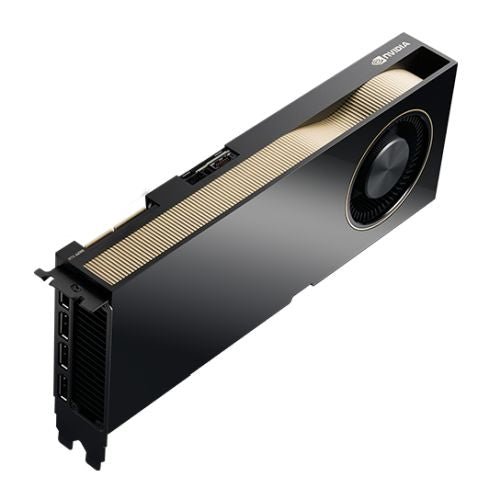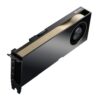PNY RTXA6000 Professional Graphics Card, 48GB DDR6, 4 DP, Ampere Ray Tracing, 10752 Core, NVLink support, OEM (Brown Box)
Experience superior graphics performance with the PNY RTXA6000 Professional Graphics Card. This powerful device boasts 48GB DDR6 memory, 10752 cores, and Ampere Ray Tracing technology, ensuring smooth and realistic visuals. It also supports NVLink for multi-GPU setups and comes in a convenient OEM brown box.
- 48GB DDR6 memory
- 10752 core power
- Ampere Ray Tracing technology
- 4 DisplayPort connections
- NVLink support
- OEM brown box packaging
£4,210.28
In stock
Next day delivery on orders placed before 3PM Mon-Fri
Performance Amplified
The world of professional visualization is evolving rapidly. Advanced requirements like real-time ray tracing, AI, compute, engineering simulation, and immersive VR are common across industries, while millions of professionals have shifted to working from home.
The NVIDIA RTX A6000 delivers everything designers, engineers, and artists need to meet today’s demands from their desktop. Built on the NVIDIA Ampere architecture, the RTX A6000 combines 84 second-generation RT Cores, 336 third-generation Tensor Cores, and 10,752 CUDA cores with 48 GB of graphics memory for unprecedented rendering, AI, graphics, and compute performance. Connect two RTX A6000s with NVIDIA NVLink™ for 96 GB of combined GPU memory. And access the power of your workstation from anywhere with remote-access software. Engineer amazing products, design state-of-the art buildings, drive scientific breakthroughs, and create immersive entertainment with the world’s most powerful graphics solution.
NVIDIA Ampere Architecture
NVIDIA RTX A6000 is the most powerful workstation GPU NVIDIA offering high performance real-time ray tracing, AI-accelerated compute, and professional graphics rendering. Building upon the major SM enhancements from the Turing GPU, the NVIDIA Ampere architecture enhances ray tracing operations, tensor matrix operations, and concurrent executions of FP32 and INT32 operations.
CUDA Cores
The NVIDIA Ampere architecture-based CUDA cores bring up to 2X the single-precision floating point (FP32) throughput compared to the previous generation, providing significant performance improvements for graphics workflows such as 3D model development and compute for workloads such as desktop simulation for computer-aided engineering (CAE). The RTX A6000 enables two FP32 primary data paths, doubling the peak FP32 operations.
Second Generation RT Cores
Incorporating second generation ray tracing engines, NVIDIA Ampere architecture-based GPUs provide incredible ray traced rendering performance. A single RTX A6000 board can render complex professional models with physically accurate shadows, reflections, and refractions to empower users with instant insight. Working in concert with applications leveraging APIs such as NVIDIA OptiX, Microsoft DXR and Vulkan ray tracing, systems based on the RTX A6000 will power truly interactive design workflows to provide immediate feedback for unprecedented levels of productivity. The RTX A6000 is up to 2X faster in ray tracing compared to the previous generation. This technology also speeds up the rendering of ray-traced motion blur for faster results with greater visual accuracy.
Third Generation Tensor Cores
Purpose-built for deep learning matrix arithmetic at the heart of neural network training and inferencing functions, the RTX A6000 includes enhanced Tensor Cores that accelerate more datatypes, and includes a new Fine-Grained Structured Sparsity feature that delivers up to 2X throughput for tensor matrix operations compared to the previous generation. New Tensor Cores will accelerate two new TF32 and BFloat16 precision modes. Independent floating-point and integer data paths allow more efficient execution of workloads using a mix of computation and addressing calculations.
PCIe Gen 4
The RTX A6000 supports PCI Express Gen 4, which provides double the bandwidth of PCIe Gen 3, improving data-transfer speeds from CPU memory for data-intensive tasks like AI and data science.
Higher Speed GDDR6 Memory
Built with 48GB GDDR6 memory delivering up to 15% greater throughput for ray tracing, rendering, and AI workloads than the previous generation. The RTX A6000 provides the industry’s largest graphics memory footprint to address the largest datasets and models in latency-sensitive professional applications.
Error Correcting Code (ECC) on Graphics Memory
Meet strict data integrity requirements for mission critical applications with uncompromised computing accuracy and reliability for workstations.
Fifth Generation NVDEC Engine
NVDEC is well suited for transcoding and video playback applications for real-time decoding. The following video codecs are supported for hardware-accelerated decoding: MPEG-2, VC-1, H.264 (AVCHD), H.265 (HEVC), VP8, VP9, and AV1.
Seventh Generation NVENC Engine
NVENC can take on the most demanding 4K or 8K video encoding tasks to free up the graphics engine and the CPU for other operations. The RTX A6000 provides better encoding quality than software-based x264 encoders.
Graphics Preemption
Pixel-level preemption provides more granular control to better support time-sensitive tasks such as VR motion tracking.
Compute Preemption
Preemption at the instruction-level provides finer grain control over compute tasks to prevent long-running applications from either monopolizing system resources or timing out.
NVIDIA RTX IO
Accelerating GPU-based lossless decompression performance by up to 100x and 20x lower CPU utilization compared to traditional storage APIs using Microsoft’s new DirectStorage for Windows API. RTX IO moves data from the storage to the GPU in a more efficient, compressed form, and improving I/O performance.
| Weight | 1.5 kg |
|---|






